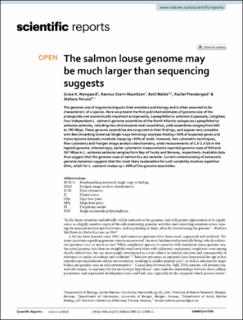| dc.contributor.author | Wyngaard, Grace | |
| dc.contributor.author | Skern-Mauritzen, Rasmus | |
| dc.contributor.author | Malde, Ketil | |
| dc.contributor.author | Prendergast, Rachel | |
| dc.contributor.author | Peruzzi, Stefano | |
| dc.date.accessioned | 2022-04-27T12:52:13Z | |
| dc.date.available | 2022-04-27T12:52:13Z | |
| dc.date.created | 2022-04-22T20:46:23Z | |
| dc.date.issued | 2022 | |
| dc.identifier.issn | 2045-2322 | |
| dc.identifier.uri | https://hdl.handle.net/11250/2993050 | |
| dc.description.abstract | The genome size of organisms impacts their evolution and biology and is often assumed to be characteristic of a species. Here we present the first published estimates of genome size of the ecologically and economically important ectoparasite, Lepeophtheirus salmonis (Copepoda, Caligidae). Four independent L. salmonis genome assemblies of the North Atlantic subspecies Lepeophtheirus salmonis salmonis, including two chromosome level assemblies, yield assemblies ranging from 665 to 790 Mbps. These genome assemblies are congruent in their findings, and appear very complete with Benchmarking Universal Single-Copy Orthologs analyses finding > 92% of expected genes and transcriptome datasets routinely mapping > 90% of reads. However, two cytometric techniques, flow cytometry and Feulgen image analysis densitometry, yield measurements of 1.3–1.6 Gb in the haploid genome. Interestingly, earlier cytometric measurements reported genome sizes of 939 and 567 Mbps in L. salmonis salmonis samples from Bay of Fundy and Norway, respectively. Available data thus suggest that the genome sizes of salmon lice are variable. Current understanding of eukaryotic genome dynamics suggests that the most likely explanation for such variability involves repetitive DNA, which for L. salmonis makes up ≈ 60% of the genome assemblies. | en_US |
| dc.language.iso | eng | en_US |
| dc.publisher | Nature | en_US |
| dc.rights | Navngivelse 4.0 Internasjonal | * |
| dc.rights.uri | http://creativecommons.org/licenses/by/4.0/deed.no | * |
| dc.title | The salmon louse genome may be much larger than sequencing suggests | en_US |
| dc.type | Journal article | en_US |
| dc.type | Peer reviewed | en_US |
| dc.description.version | publishedVersion | en_US |
| dc.rights.holder | Copyright 2022 The Author(s) | en_US |
| dc.source.articlenumber | 6616 | en_US |
| cristin.ispublished | true | |
| cristin.fulltext | original | |
| cristin.qualitycode | 1 | |
| dc.identifier.doi | 10.1038/s41598-022-10585-2 | |
| dc.identifier.cristin | 2018531 | |
| dc.source.journal | Scientific Reports | en_US |
| dc.identifier.citation | Scientific Reports. 2022, 12, 6616. | en_US |
| dc.source.volume | 12 | en_US |

